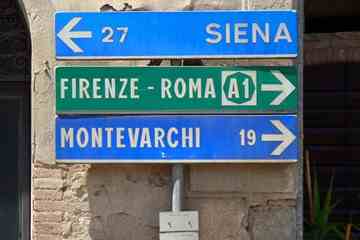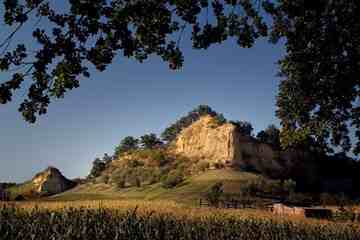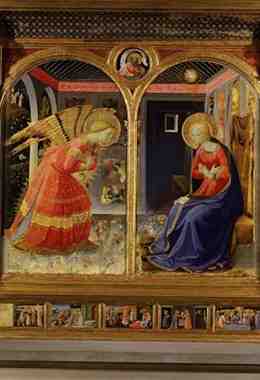In Tuscany, small sun-baked towns shuffle past your car or train window like so many filed-away postcards, leaving a pleasant but undistinguished impression as you make your way to Florence, Siena or Pisa. Yet for travelers with the right kind of eyes, dodging through the hills to visit these tiny towns can be the best way to understand Tuscany, while providing a calmer, more personalized experience.
 One group of these towns, well off the tourist charts, is in the Valdarno (literally "Valley of the Arno"), which propelled Florence's power throughout the region in the late Middle Ages. Three towns of the Valdarno—a 30-minute train ride from Florence—were called "Terre Nuove," new lands, and served as bulwarks against feudalism and an experiment in urban planning.
One group of these towns, well off the tourist charts, is in the Valdarno (literally "Valley of the Arno"), which propelled Florence's power throughout the region in the late Middle Ages. Three towns of the Valdarno—a 30-minute train ride from Florence—were called "Terre Nuove," new lands, and served as bulwarks against feudalism and an experiment in urban planning.
Seven hundred years later, Tuscans from the Valdarno are often more Florentine than people from Florence, says Paolo Pirillo, a professor from the University of Bologna.
"In the Valdarno, they have the strongest ties to Florence, and this is an identity they've dragged behind them for centuries," says Mr. Pirillo, who is part of a team leading the development of a museum in San Giovanni dedicated to the Terre Nuove.
Authorities at a local and provincial level are hoping to increase tourism to the region through the museum, Museo delle Terre Nuove, which after some delays officials hope will open late next year.
Valdarno's cities have never resided at the top of tourist must-visit lists in Tuscany, but they should, especially for any visitor with a will to dig deeper into Tuscan history and culture. Residents note that the Valdarno's defining characteristic is a fierce willingness to amplify tradition with innovation. There's still a sort of cowboy spirit to the place. "We're adventurers," says San Giovanni resident Cristiano Magi.
 Some of the towns were founded to serve as laboratories in arts and architecture, urban planning and social engineering: what happened here first often appeared later in Florence.
Some of the towns were founded to serve as laboratories in arts and architecture, urban planning and social engineering: what happened here first often appeared later in Florence.
"It's often suggested that in the construction of the new towns, Arnolfo di Cambio adapted a number of solutions that were then used in the enlargement of Florence's city walls," says Fausto Forte, director of cultural services for the municipality of San Giovanni. Di Cambio was the Italian architect responsible for the planning and execution of San Giovanni and he worked on many a historic commission in Florence. "These cities, therefore, become a sort of training facility."
The city also trained crucial artists like Masaccio, the prodigy who, despite dying at age 27, achieved innovations in painting that are widely credited as presaging the Renaissance. Today, the 15th-century artist's San Giovanni home is a gallery frequently showcasing contemporary artists.
During a two-part exhibition on a warm night in October, a short stroll showed the depth of San Giovanni's artistic offerings. At Casa Masaccio, an exhibition themed around the Annunciation displayed—through the narrow halls and square rooms of the house—a series of ethereal and surreal video exhibits. One video showed a woman rearranging a room full of chairs, while another installation framed a visual poem set to a cold-toned cinematic take of a horse running on sand.
Around the corner on the city's central plaza, the Museo Della Basilica's whole collection sets the stage for its centerpiece: one of Fra Angelico's depictions of the Annunciation, whose presence in San Giovanni inspired the theme for the Masaccio's exhibition. The painting is one of Fra Angelico's most important works, and a theme which the famed 15th-century painter touched upon frequently.
"The Basilica museum has an important core of works from the Renaissance. And of Angelico's three Annunciations—one is stored at the Diocesan Museum in Cortona, the other at the Prado in Madrid—this is the earliest one he executed," Mr. Forte says.
 Artists such as Masaccio and Fra Angelico were surely inspired, as all their Tuscan counterparts, by the beauty of Tuscany, with its wilderness-studded hills and cobbled towns, the pleasant climate and the wine country. But Valdarno was different, and from its inception, the region spurred citizens and artisans alike to innovate. Florence founded San Giovanni by edict in 1299 to serve as a bulwark between rival city states. "Developing a new city meant creating everything a city could offer," Mr. Pirillo says.
Artists such as Masaccio and Fra Angelico were surely inspired, as all their Tuscan counterparts, by the beauty of Tuscany, with its wilderness-studded hills and cobbled towns, the pleasant climate and the wine country. But Valdarno was different, and from its inception, the region spurred citizens and artisans alike to innovate. Florence founded San Giovanni by edict in 1299 to serve as a bulwark between rival city states. "Developing a new city meant creating everything a city could offer," Mr. Pirillo says.
Among the biggest surprise that visitors making the rounds of famous Tuscan towns will note is San Giovanni's open-grid layout, a break from the way Tuscan towns had been laid out in the past and part of di Cambio's search for an ideal urban design.
The city features one grand avenue, Corso Italia, on which all public life gathers. The street, and the rectangular piazza in its center, create a sort of stage, giving observers a full view of the city's goings-on. At any given moment in the afternoon, dozens of bikers glide by shoppers dipping in and out of cafés and newsstands. A number of cafés extend service well into the street, where patrons sip on espresso while looking back at the elegant arches that extend over the ground-level shops. The streets running parallel to the corso get smaller as they approach the old city walls, and calm, intimate eateries pop out from under quiet arcades or extend dining areas onto the streets throughout the town. Try a stop at Osteria Garibaldi on Via Garibaldi, where the cook adds a twist to classic Tuscan dishes, spicing up, for example, a traditional potato-and-rosemary dish with a daring note of ginger.
To best experience one element of di Cambio's design aesthetic, hop a bus to nearby Castelfranco di Sopra, a town nestled between the hills with about 3,000 residents. Here, multicolored brick-and-plaster noble houses hide a series of alleys called chiassi, which are also present in San Giovanni but best experienced here. The alleyways hold a honeycomb of tiled rooftops, terraces and clotheslines safe from the afternoon sun. Colors appear saturated in the dimmed light and the tall medieval walls lean in to create a cloistered feeling.
In other towns, along with authorities' recent efforts to improve the cachet of the Valdarno region, the push is happening at a grassroots level, perhaps nowhere more so than in Montevarchi, a town that is just a two-minute train ride from San Giovanni and of roughly equal size. Montevarchi is older than the Terre Nuove. Its old city walls still stand at the spot where Florence's holdings ran up against the border of rival Arezzo.
 One of Montevarchi's central arteries, Via Isidoro del Lungo, pushes past a number of churches and museums to a stretch of old buildings that host six workshops of furniture and antiques restorers. One of them belongs to Marco Agnolucci, a native son who put together the Via dei Musei association that seeks to promote the city's cultural offerings. Mr. Agnolucci points out that Montevarchi was a crucial way station on old trade routes until the 1800s, and long-forgotten traces of Florence's powerful past lay hidden everywhere, including in one of the Medici's most important granaries, currently hidden away in the basement of a local bank.
One of Montevarchi's central arteries, Via Isidoro del Lungo, pushes past a number of churches and museums to a stretch of old buildings that host six workshops of furniture and antiques restorers. One of them belongs to Marco Agnolucci, a native son who put together the Via dei Musei association that seeks to promote the city's cultural offerings. Mr. Agnolucci points out that Montevarchi was a crucial way station on old trade routes until the 1800s, and long-forgotten traces of Florence's powerful past lay hidden everywhere, including in one of the Medici's most important granaries, currently hidden away in the basement of a local bank.
A recent exhibition at the Collegiata di San Lorenzo, located in a church on Piazza Varchi that is considered to be one of the best examples of Tuscan baroque, reflected on the work of Massimiliano Soldani Benzi, a Montevarchi sculptor whose fame as a Baroque artist reached Rome in the 18th century, and whose works adorned the facades of Florence. "He was the greatest Italian master of the Baroque era," says Mr. Agnolucci, "and for 40 years, the greatest sculptor of bronze in all of Europe."
Adjacent to the Collegiata, the Museo d'Arte Sacre's holdings include works by the Della Robbias, while the new Cassero Per La Scultura sculpture museum, which opened in May in a tower of the original city wall, now at the head of Via Trieste, displays three floors of work by contemporary Italian sculptors, including Pietro Guerri and Timo Bortolotti.
Not to be missed is the six-day-a-week market on Piazza dell'Antica Gora in Montevarchi, an open-air market that only offers stands to small-scale agricultural producers with an aim for high-quality merchandise. The market's popularity has boomed in recent years. Go early, advises local filmmaker and Montevarchi native Beppe Mangione. "It's great because they used to do it only once a month. You can buy milk on tap, meats and cheeses from local producers."
From San Giovanni's Masaccio, whose advances in figurative painting, particularly in the use of perspective, heralded a new way of conceiving and executing art, to Benzi, Valdarno's cities have produced an outsized output of significant and innovative artists and artisans. The tradition continues today. Casa Masaccio makes a dedicated effort to showcase artists who tie tradition to a drive for innovation. In Montevarchi, the new Cassero museum for sculpture on Piazza Veneto displays three floors of work by contemporary Italian sculptors. And in a notable effort over the summer, in nearby Pergine Valdarno, a spinning mill long in disuse was converted into temporary studio space for artists to work and collaborate, with a final two-day exhibition, "Made in Filandia," that was successful enough to encourage organizers to make it a regular event.
Meanwhile, organizers hope that the Museo delle Terre Nuove will be set to open on schedule later this year. At which point, the secret of the Valdarno will be out. "On this street alone there are three museums," pointed out Mr. Mangione, the Montevarchi filmmaker. "And the collections that are here, they arrive from all over Italy."
Author: Joel Weickgenant | Source: The Wall Street Journal [November 19, 2010]